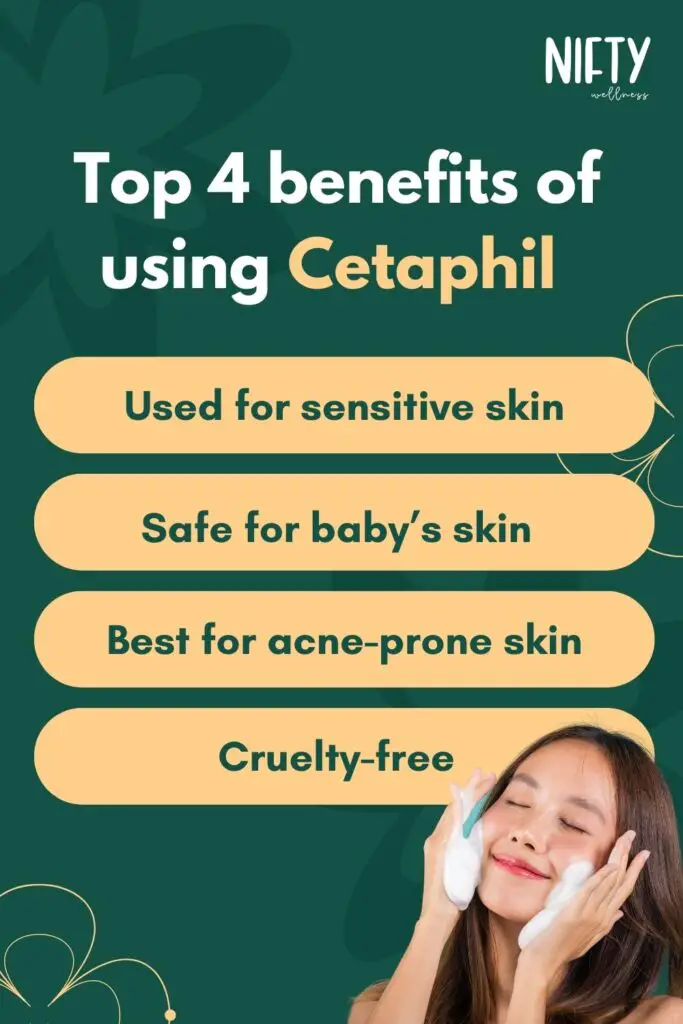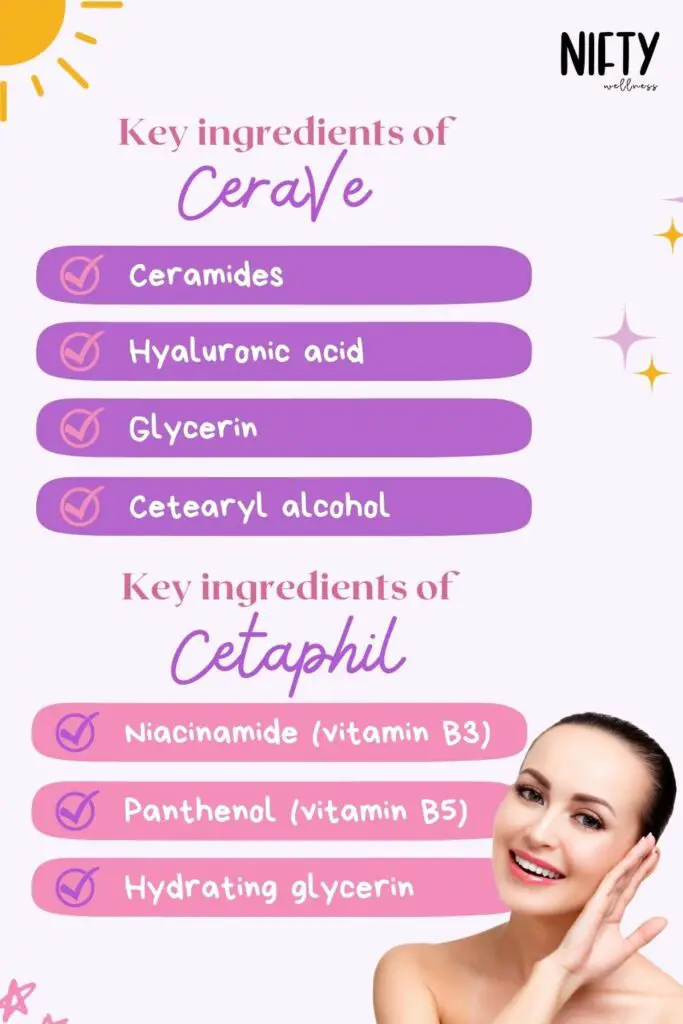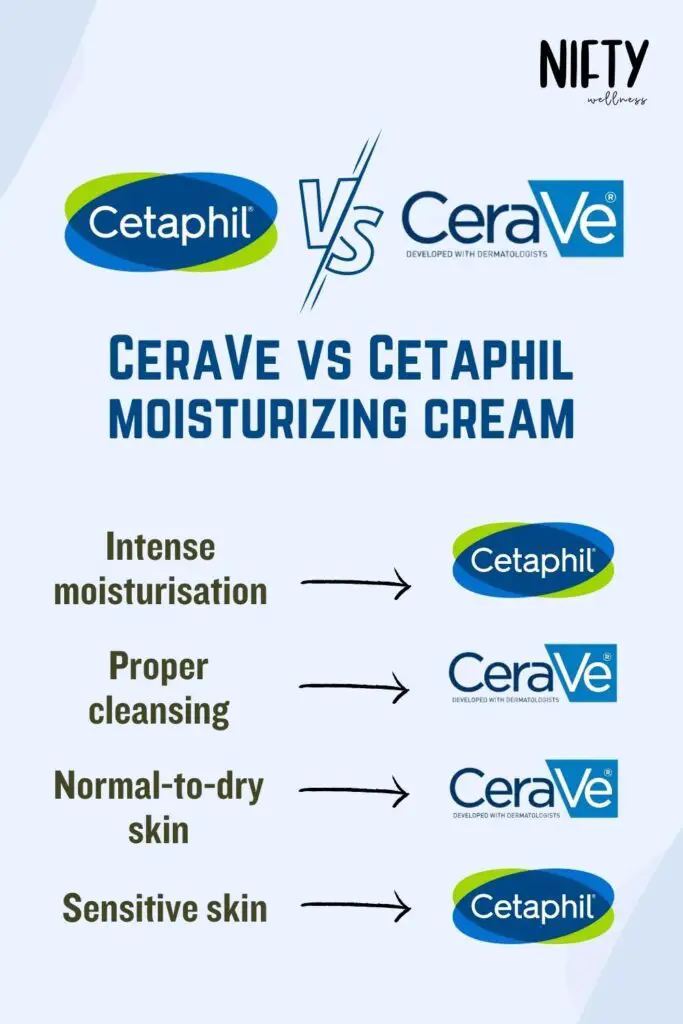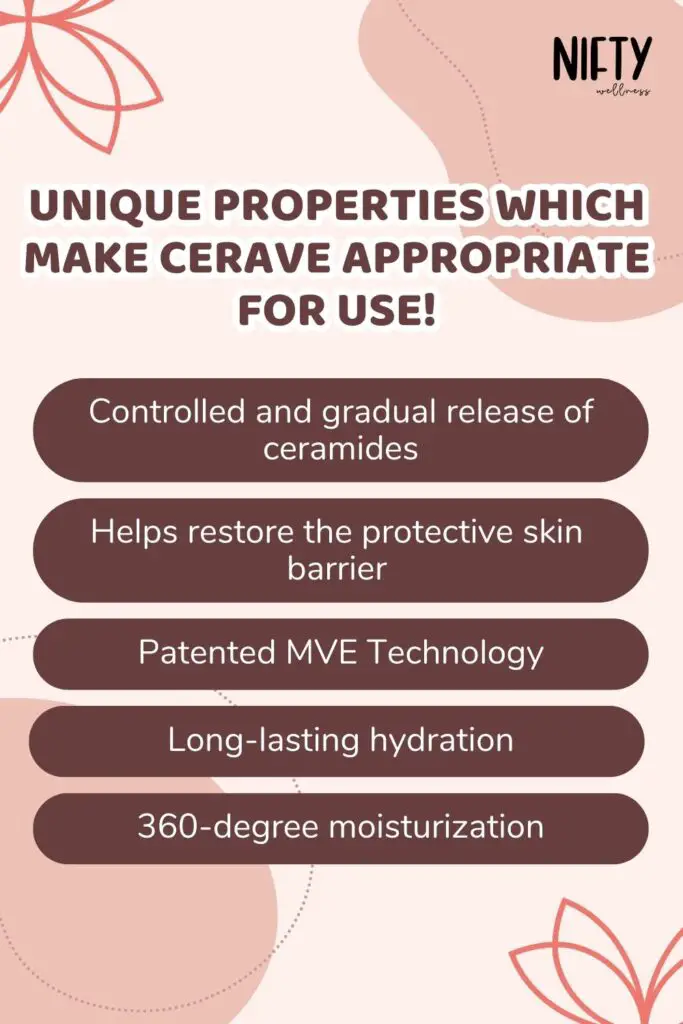In the realm of skincare, choosing the right products can make all the difference in the world. It is a decision that shapes your daily routine and ultimately, the health and beauty of your skin.
Among the myriad of options available in the market, two brands stand out in the crowd: CeraVe and Cetaphil.
Both renowned for their skincare lines, they have become the go-to choice for many skincare enthusiasts. But which one reigns supreme? Is it CeraVe with its ceramide-rich formulations or Cetaphil and its gentle, hypoallergenic solutions?
Let’s delve deeper into the CeraVe vs. Cetaphil face-off to make an informed decision that your skin will thank you for.
Understanding CeraVe and Cetaphil
CeraVe, the first contender in our CeraVe vs. Cetaphil comparison, is a skincare brand developed with the expertise of dermatologists. Known for their ceramide-infused range, CeraVe focuses on reinforcing and replenishing the skin’s natural barrier. Ceramides are essential to retaining moisture and preventing dryness and irritation, and CeraVe’s unique formula, containing three essential ceramides, ensures this.

On the other hand, Cetaphil is a globally recognized skincare brand that caters to a wide array of skincare needs. Noted for its gentle, hypoallergenic formulas, Cetaphil offers products that cleanse, moisturize, and protect the skin without causing irritation. Its range caters to various skin types, including sensitive, acne-prone, and dry skin, making it a versatile choice in the skincare world.
In the CeraVe vs. Cetaphil face-off, it’s clear that both brands offer unique advantages. CeraVe brings the power of ceramides to the table, promoting skin health and moisture retention, while Cetaphil shines with its gentle, versatile range that accommodates numerous skin types and needs.
The Cleanser Battle: CeraVe vs. Cetaphil
When it comes to skincare, choosing the right cleanser can make all the difference. Today, we’re comparing two fan favorites: CeraVe’s Hydrating Facial Cleanser and Cetaphil’s Gentle Skin Cleanser. Both have their merits, but which one will emerge as the superior choice? Let’s dive in.
Effectiveness
CeraVe’s Hydrating Facial Cleanser is specially formulated for normal-to-dry skin types. This cleanser effectively removes dirt, makeup, and debris without compromising the skin’s natural protective barrier or stripping away essential moisture. After use, your skin will feel refreshed and deeply hydrated, rather than tight or dry. Users rave about the soft, clean, and well-moisturized feeling it provides.
On the other hand, Cetaphil’s Gentle Skin Cleanser boasts a creamy formula that is perfect for normal to dry, sensitive skin. It effortlessly eliminates dirt, makeup, and impurities while delivering continuous hydration to safeguard against dryness. The result is clean, soothed, and thoroughly hydrated skin. In fact, an impressive 95% of users reported feeling the gentle cleansing power of this product.
With these two exceptional cleansers, you can choose the one that suits your skin type and enjoy the benefits of a refreshed, nourished, and healthy-looking complexion.
Key Ingredients

The CeraVe Hydrating Facial Cleanser boasts a unique blend of ingredients. Ceramides and hyaluronic acid work together to restore the skin’s natural barrier and lock in moisture. The MVE Delivery Technology ensures efficient delivery of these ceramides within the skin’s barrier and slow release over time, keeping your skin hydrated long after you’ve finished applying.
Ingredients include water, glycerin, cetearyl alcohol, ceramides (NP, AP, EOP), sodium hyaluronate, and cholesterol. These ingredients help maintain the skin’s natural barrier, retain its moisture, and keep it hydrated.
Conversely, the Cetaphil Gentle Skin Cleanser is formulated with a blend of niacinamide (vitamin B3), panthenol (vitamin B5), and hydrating glycerin. These ingredients improve the resilience of sensitive skin and provide continuous hydration to protect against dryness.
Ingredients include water, glycerin, cetearyl alcohol, panthenol, niacinamide, and sodium cocoyl isethionate. These ingredients work together to cleanse the skin gently, improve skin resilience, and provide hydration.
To sum up, both CeraVe and Cetaphil are effective cleansers that cater to different skin types and needs. CeraVe’s Hydrating Facial Cleanser may be a better fit for those with normal-to-dry skin looking to retain moisture and restore their skin’s natural barrier. Meanwhile, Cetaphil’s Gentle Skin Cleanser could be the go-to for individuals with dry to normal, sensitive skin seeking gentle cleansing and improved skin resilience.
Moisturizer Showdown: CeraVe vs. Cetaphil

In the world of skincare, the debate of Cerave vs Cetaphil moisturizer is a heated one. Both brands have garnered a loyal customer base with their unique formulations aimed at varied skin types. Let’s delve into the moisturizing properties and key ingredients of these popular products.

First of all, CeraVe Moisturizing Cream offers a unique, patented MVE Technology that offers a controlled and gradual release of ceramides and other key ingredients throughout the day. This technology ensures long-lasting hydration and helps restore the protective skin barrier, making it an ideal choice for individuals with dry and sensitive skin.
On the other hand, Cetaphil Rich Hydrating Cream, designed for dry to normal sensitive skin, harnesses the power of Hyaluronic Acid – a vital ingredient known for its intense hydration properties. It protects the skin from dryness for a full 24 hours. It also fights against 5 signs of skin sensitivity including dryness, irritation, roughness, tightness, and a weakened skin barrier, making it a great option for those with sensitive skin.
So, in this showdown, it boils down to personal preference and specific skin needs. If your skin leans towards the drier side, CeraVe’s slow-release technology may offer a more sustained moisturizing effect. However, if your skin is sensitive and you’re looking for a product that combats multiple signs of skin sensitivity, Cetaphil could be the one for you.
In the battle of Cerave vs Cetaphil cream, it’s clear that both brands offer high-quality products packed with beneficial ingredients. Both the CeraVe Moisturizing Cream and Cetaphil Rich Hydrating Cream are excellent options for replenishing and maintaining your skin’s natural moisture barrier. However, your ultimate choice between Cerave vs Cetaphil moisturizing cream would depend on your skin type, and the specific skin concerns you are looking to address.
Unravel the dissimilarities and resemblances to find your ideal skincare match with “Cerave VS Aveeno: Differences, Similarities & Which One Is Right For You“.
Moisturizer battle: Is CeraVe or Cetaphil better for dry skin?

When it comes to managing dry skin, both CeraVe and Cetaphil offer excellent solutions. Here’s a side-by-side comparison to help you evaluate which one might be the better choice for your individual needs:
| Aspect | CeraVe Moisturizing Cream | Cetaphil Rich Hydrating Cream |
| Key Ingredients | MVE Technology, Ceramides, Hyaluronic Acid | Hyaluronic Acid, Vitamin E, Vitamin B5 |
| Hydration Duration | 24 hours with a slow-release technology | 24 hours |
| Skin Type | Dry to Very Dry Skin | Dry to Normal Skin |
| Special Feature | Restores and maintains the skin’s natural protective barrier | Fights against 5 signs of skin sensitivity |
| Texture | Rich and creamy | Lightweight and non-greasy |
| Fragrance | Fragrance-free | Fragrance-free |
| Recommended Usage | Can be used any time of the day and as often as desired | Can be used daily, during the morning and evening |
In conclusion, both CeraVe and Cetaphil have their unique strengths when it comes to hydrating dry skin. CeraVe’s formula is more suited towards dry to normal skin types, thanks to its slow-release technology and a higher concentration of ceramides, while Cetaphil offers a lightweight, non-greasy formula that caters to the same dry to normal skin types but also combats multiple signs of skin sensitivity. If you are still confused, it is advisable to patch-test both products to see which one suits your skin the best.
Real User Experiences: CeraVe vs. Cetaphil
As we delve deeper into the debate of CeraVe vs. Cetaphil, it’s crucial to look at real user experiences. Renowned skincare YouTuber Hyram delivers a strong verdict, stating in his YouTube video, “Which brand is better? I can confidently say, from a formulation perspective as well as my personal experiences with the products, CeraVe is the winner.” His confidence in CeraVe springs from his thorough testing and understanding of the brand’s formulation.
On the other end of the spectrum, Dr. Vanita Rattan shares a more balanced view on the CeraVe vs. Cetaphil conundrum. She asserts in her YouTube video review, “CeraVe versus Cetaphil, they’re both very good brands. I don’t love all the products in both their ranges, but I do like a lot of the products.” She further explains, “In summary, both CeraVe and Cetaphil have their strengths and weaknesses. CeraVe offers gentle and hydrating cleansers with additional beneficial ingredients like ceramides…Cetaphil, on the other hand, provides basic and gentle cleansers and moisturizers without many additional actives.”
Adding another perspective to our CeraVe vs. Cetaphil discussion, YouTube Rob from @MadAboutSkin highlights the benefits for those with sensitive skin. He comments, “Cetaphil products contain fewer ingredients than CeraVe which is a good thing for those with sensitive skin and they don’t use the same ingredients (like niacinamide) in all their products which again is a plus.”
In summary, the comparison of CeraVe vs. Cetaphil, informed by real user experiences and expert evaluations, appears to be a draw. CeraVe is lauded for its formulation and beneficial ingredients like ceramides, while Cetaphil is favored for its gentle, simple approach, particularly suited to those with sensitive skin.
These insights provide a holistic view of the two brands and their offerings, adding valuable context to our CeraVe vs. Cetaphil comparison.
Explore divergences and commonalities to discover the perfect fit for your skincare needs with “Cetaphil VS Physiogel: Differences, Similarities & Which One Is Right For You“.
The Price Factor: Comparing CeraVe vs. Cetaphil Products
When examining the price point of CeraVe and Cetaphil skincare products, we find some differences that might sway consumers in one direction or the other. CeraVe products, while renowned for their advanced formulations with ceramides, tend to be slightly pricier. For instance, their popular Hydrating Facial Cleanser retails for around $14.99 for a 12 fl oz bottle on their official US website. On the other hand, Cetaphil’s Gentle Skin Cleanser, which is praised for its simplicity and gentleness, is slightly more affordable, priced at around $17.79 for a 20 fl oz on their US site. Similarly, when comparing moisturizers, CeraVe’s PM Facial Moisturizing Lotion is marked at $19.99 for a 3 fl oz bottle, whereas the comparable Cetaphil Daily Hydrating Lotion is a little lower, costing around $14.99 for the same size. Therefore, while both brands offer quality skincare products, Cetaphil might be a more budget-friendly option for those mindful of cost. It’s important to remember, however, that pricing may vary based on the location, and any ongoing promotions or sales.
Conclusion
In conclusion, the CeraVe vs. Cetaphil debate isn’t a simple one-size-fits-all answer. Each brand has its own merits and caters to different skincare needs. CeraVe, with its unique blend of ceramides and other beneficial ingredients, might be the go-to choice for those seeking additional actives in their skincare routine. On the other hand, Cetaphil’s minimalistic formulation might be the better option for those with sensitive skin who prefer fewer ingredients. Ultimately, the choice between CeraVe and Cetaphil will come down to your individual skincare needs and preferences. Remember, it’s always recommended to patch test new products and consult a dermatologist if you have specific skin concerns.
Frequently Asked Questions (FAQs)
Can CeraVe and Cetaphil be used for sensitive skin?
Yes, both CeraVe and Cetaphil are suitable for sensitive skin. CeraVe’s range is formulated with essential ceramides and hyaluronic acid which can help restore and maintain the skin’s natural barrier, while Cetaphil’s products are known for their gentle, non-irritating formulas. However, if you have highly sensitive skin or specific skin conditions, it is always advisable to consult with a dermatologist before trying new products.
Are CeraVe and Cetaphil cruelty-free?
Both CeraVe and Cetaphil are committed to creating quality skincare products without animal testing. CeraVe, owned by L’Oréal, adheres to the parent company’s policy of not testing on animals unless required by laws or regulations. Cetaphil, owned by Galderma, also maintains a cruelty-free stance. However, it’s always beneficial to research each brand’s most updated policies as changes can occur.
Which brand among CeraVe and Cetaphil is better for acne-prone skin?
Both CeraVe and Cetaphil have products suitable for acne-prone skin. CeraVe’s cleansers, specifically the Foaming Facial Cleanser, contain niacinamide which can aid in reducing acne flare-ups. On the other hand, Cetaphil’s Gentle Skin Cleanser is non-comedogenic and can help maintain skin’s natural pH balance. However, skincare results can vary greatly among individuals, so personal trial and consultation with a dermatologist are important.
Can CeraVe and Cetaphil be used together?
Absolutely, CeraVe and Cetaphil can complement each other in a skincare routine. For instance, you could use a CeraVe cleanser for its ceramide benefits and follow up with a Cetaphil moisturizer for its hydrating properties. This combination can provide a comprehensive skincare regimen. As always, individuals should monitor their skin’s response and adjust usage accordingly.
Are CeraVe and Cetaphil safe for children?
Yes, both CeraVe and Cetaphil are generally safe for children’s skin. They offer specific lines tailor-made for babies and children that are free of parabens and phthalates. However, due to the delicate nature of children’s skin, it’s always advisable to patch test any new product. If your child has any specific skin issues or sensitivities, seeking advice from a pediatric dermatologist is recommended.
